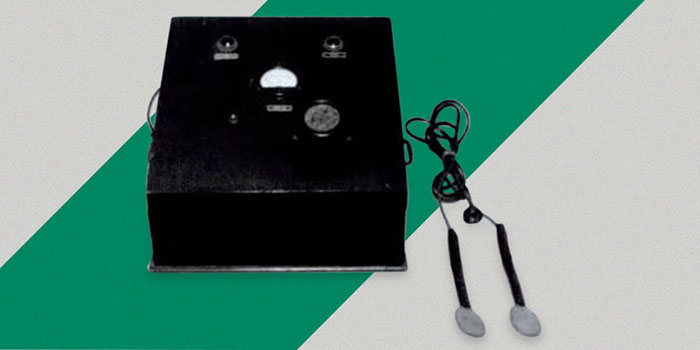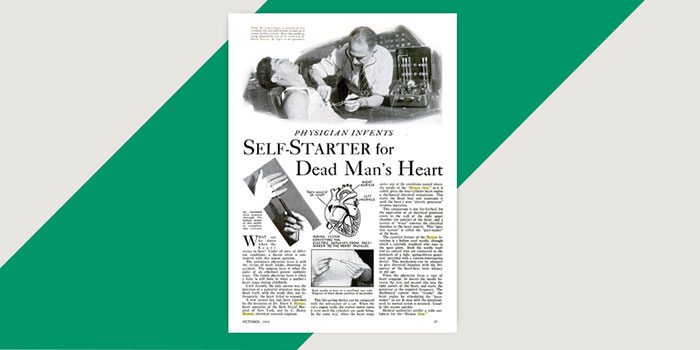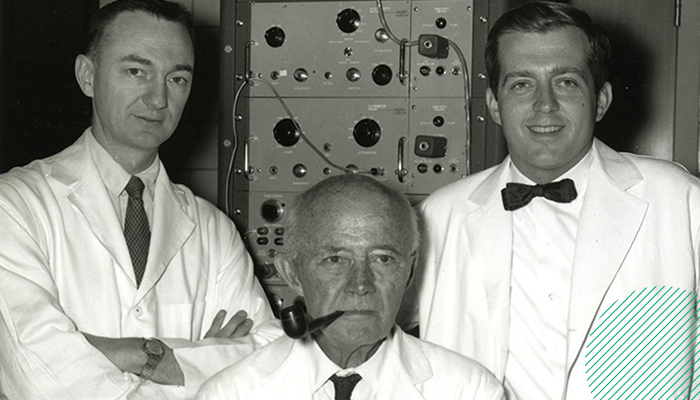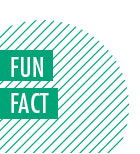Who Invented the Defibrillator: The Response Tech Against Sudden Cardiac Arrest
You see them everywhere — at restaurants, conference halls and shopping centers — automatic external defibrillators are at the ready in all manner of public places.
But this wasn’t always the case.
While the portable and compact devices are plentiful now and can be used with relative ease, the first iterations of the device were much more invasive and required a high level of expertise.
SIGN UP: Get more news from the HealthTech newsletter in your inbox every two weeks
WHAT Is a Defibrillator?

The defibrillator used by Claude Beck in 1947. Photo courtesy of John Field via Wikimedia.
Simply put, a defibrillator is a device that delivers electric shocks through the chest to the heart, according to the American Heart Association. The procedure “causes depolarisation of the heart muscles and re-establishes normal conduction of the heart’s electrical impulse,” Dr. Ananya Mandal explains in News Medical Life Sciences.
Defibrillation treats life-threatening conditions that can impact the heart’s rhythm, including cardiac arrhythmia, ventricular fibrillation and pulseless ventricular tachycardia. With heart disease still the leading cause of death in the U.S. — most deaths are caused by sudden cardiac arrest in which the heart stops beating with little or no reason — defibrillators have a large role to play in saving lives across the country.
Over time, the defibrillator has taken on several forms, including transvenous and implanted defibrillators that can sit inside the body to deliver an electric shock as necessary, but the automated external defibrillator has become the most popular version of the device.
Often seen in hospitals, emergency sites or other public places in order to treat sudden cardiac arrest, the technology has two paddles that are pressed to a person’s chest after a conductive gel or electrodes are applied. The modern defibrillator has a built-in computer that can assess a heart’s rhythm, determine whether or not defibrillation is required, and then administer the necessary level of electric shock.
WHO Invented the Defibrillator?

An article in a 1933 issue of Popular Mechanics displaying an early ancestor of the defibrillator, the Hyman Otor device. Photo courtesy of Popular Mechanics.
Around the turn of the 20th century, cardiac arrest became a leading cause of death. While inventors had touched on the idea of using electric shock to restart the heart or correct a heartbeat beginning in the late 1800s, heart surgery pioneer Claude Beck performed the first successful defibrillation in 1947 on a 14-year-old boy experiencing ventricular fibrillation during one of his surgeries.
Beck administered an alternating current of 60Hz to the boy’s heart and, on the second try, the heart successfully restarted. Thus, defibrillation was born.
Beck’s first model was rather crude, using two silver paddles the size of tablespoons to revive patients in “open-chest situations.”
The first closed-chest defibrillation was successfully performed on a dog in 1954 by William Kouwenhoven and William Milnor, a process improved upon by Paul Zoll, who performed the first closed-chest defibrillation on a human in 1956.
The modern AED was invented in 1978. It uses sensors to automatically detect ventricular fibrillation and administer the necessary electrical shock.
WHY Are AEDs Important?

James Jude, William Kouwenhoven and Guy Knickerbocker, who contributed to the invention of the first AED. Photo courtesy of Johns Hopkins University HUB via Wikimedia.
Defibrillation technology has certainly left its mark in healthcare, but the advent of modern AEDs has allowed defibrillation to move outside of hospitals, away from the watchful eye of healthcare professionals, into the public sector.
Since their inception, AEDs have become widespread. One research firm predicts that the defibrillator market will reach more than $14 billion by 2021 as the aging population and rate of cardiovascular disease grow.
Today, the Centers for Disease Control and Prevention finds that about 610,000 people die of heart disease in the U.S. every year, accounting for one in every four deaths. Moreover, nearly 360,000 cardiac arrests assessed by emergency medical services each year occur outside of a hospital setting, according to the American Heart Association. Of these, less than 10 percent of victims survive.
With early defibrillation alongside immediate CPR, a victim’s chance of survival can more than double. And when it comes to cardiac arrest, every second counts. For every minute that passes without CPR and defibrillation, the chance of survival decreases by 7 to 10 percent.
The good news is that equipping a community with AEDs can dramatically increase the rate of survival. Communities with comprehensive AED programs that include CPR and AED training for rescuers have achieved survival rates of nearly 40 percent for cardiac arrest victims, according to the American Heart Association.
William Kouwenhoven originally devised the closed-chest defibrillator for power companies, as a way to resuscitate workers who had been electrocuted while working on power lines.
"This Old Tech" is an ongoing series about technologies of the past that had an impact. Have an idea for a technology we should feature? Please let us know in the comments!










